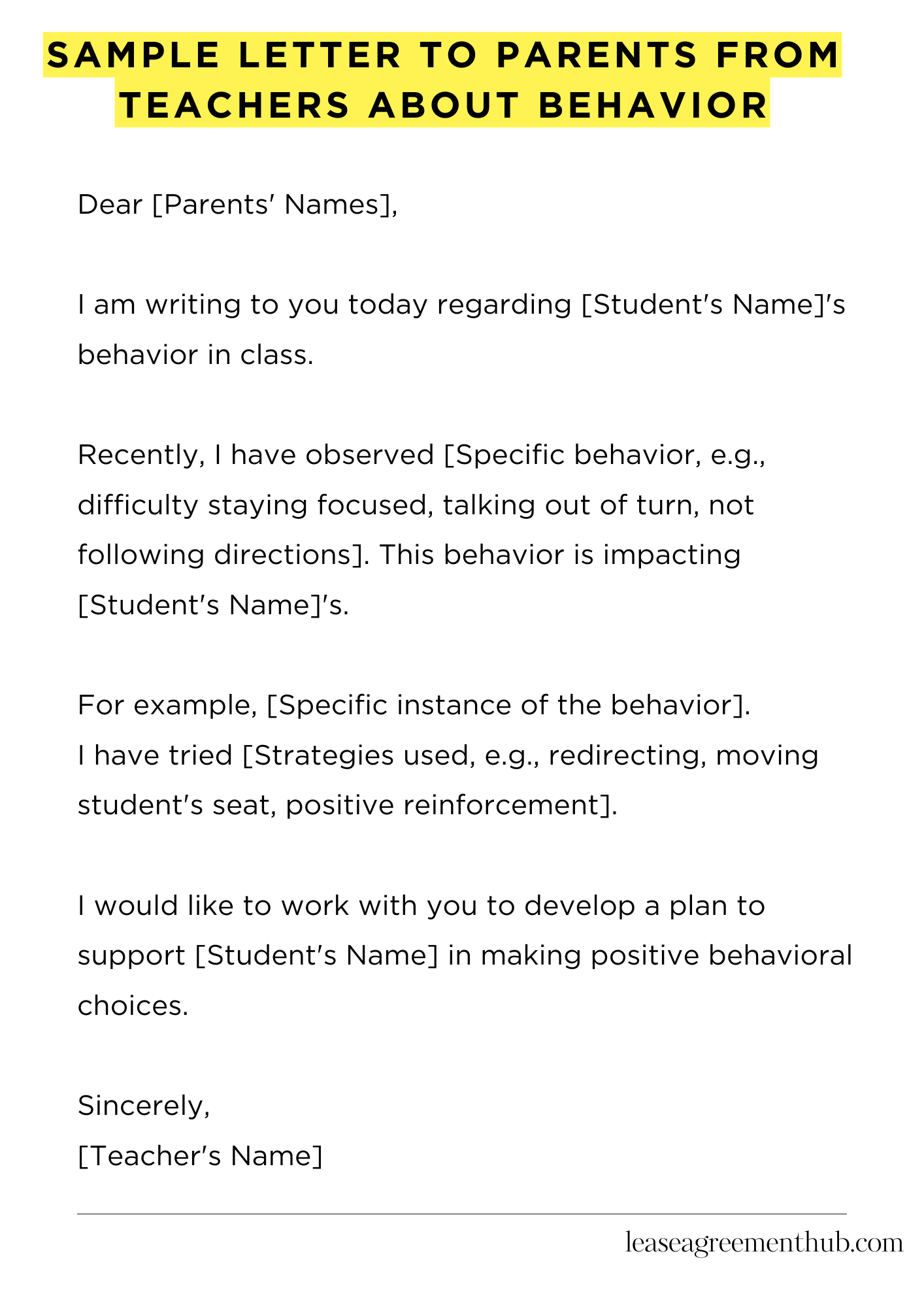Teachers often need to communicate with parents about student behavior. A “Sample Letter To Parents From Teachers About Behavior” is a pre-written template. It helps teachers address concerns clearly and professionally. These letters are used when a student’s behavior is disruptive, affecting their learning or the classroom environment.
Writing these letters can be tough. You want to be clear but also supportive. That’s why we’re here to help.
In this article, we’ll share sample letters. These examples will make it easier for you to communicate effectively. You can adapt them to fit your specific needs.
Sample Letter To Parents From Teachers About Behavior
[Date]
Dear [Parents’ Names],
I am writing to you today regarding [Student’s Name]’s behavior in class.
Recently, I have observed [Specific behavior, e.g., difficulty staying focused, talking out of turn, not following directions]. This behavior is impacting [Student’s Name]’s learning and the learning of other students.
For example, [Specific instance of the behavior].
I have tried [Strategies used, e.g., redirecting, moving student’s seat, positive reinforcement].
I would like to work with you to develop a plan to support [Student’s Name] in making positive behavioral choices. I would appreciate the opportunity to discuss this further with you.
Please feel free to contact me at [Phone number] or [Email address] to schedule a meeting.
Sincerely,
[Teacher’s Name]

How to Write Letter To Parents From Teachers About Behavior
Subject Line: Clarity is Key
- Keep it succinct and informative. A vague subject line might be overlooked.
- Instead of “Important,” try “Regarding [Student Name]’s Behavior in Class.” It cuts to the chase.
- Specificity engenders prompt attention.
Salutation: Setting the Tone
- Always err on the side of formality initially. “Dear Mr. and Mrs. [Parent’s Last Name],” demonstrates respect.
- If you have a rapport with the parents, “Dear [Parent’s First Name],” might be appropriate, but tread carefully.
- Avoid ambiguity. Know who you are addressing.
Introduction: The Gentle Nudge
- Begin by acknowledging the student’s positive attributes. Every child has them.
- Transition smoothly to the behavioral concerns. Example: “While [Student Name] excels in [Subject], I’ve observed some disruptive behaviors…”
- Offer a concise overview of the issue. Don’t inundate them with details yet.
Body: Deeper Dive with Diligence
- Provide concrete examples of the behavior. “On Tuesday, [Student Name] interrupted the lesson three times with extraneous comments.”
- Avoid generalizations and hyperbole. Stick to the facts.
- Describe the impact of the behavior on the student and the class. Is it hindering their learning or disrupting other students?
- Include the interventions you’ve already implemented. This shows initiative.
- Refrain from accusatory language. Maintain a neutral, objective voice.
Proposed Solutions: A Collaborative Approach
- Suggest specific strategies for addressing the behavior. “Perhaps a quiet signal could be used to redirect [Student Name] when they are off-task.”
- Invite parental input. “I am eager to collaborate with you to find effective solutions.”
- Outline the consequences if the behavior persists. Ensure these are in line with school policy.
Closing: Cordial and Constructive
- Reiterate your commitment to the student’s success.
- Offer to meet with the parents to discuss the matter further. “Please feel free to contact me to schedule a meeting at your convenience.”
- End on a positive note, expressing optimism for improvement.
Signature: Professional Polish
- Use your full name and title. “Sincerely, [Your Name], [Your Title]”
- Include your contact information (phone number and email address). Make it easy for parents to reach you.
- Proofread meticulously before sending. Grammatical errors undermine credibility.
Frequently Asked Questions: Behavior Letters to Parents
This section addresses common inquiries regarding letters sent home by teachers concerning student behavior. Understanding the purpose and content of these letters can foster better communication and collaboration between home and school.
Why did my child receive a behavior letter?
A behavior letter indicates that your child has exhibited behavior in the classroom that requires your attention and collaboration to address.
What information should a behavior letter contain?
A behavior letter should clearly describe the specific behavior observed, the date and time of the incident, and any consequences that were applied.
What is the purpose of a behavior letter?
The purpose of a behavior letter is to inform you about your child’s behavior at school and to encourage a joint effort in supporting positive behavior changes.
What should I do after receiving a behavior letter?
After receiving a behavior letter, discuss the situation with your child, acknowledge the teacher’s concerns, and work with the teacher to develop a plan to improve your child’s behavior.
What if I disagree with the content of the behavior letter?
If you disagree with the content of the letter, contact the teacher to schedule a meeting to discuss your concerns and gain a clearer understanding of the situation.
Related: